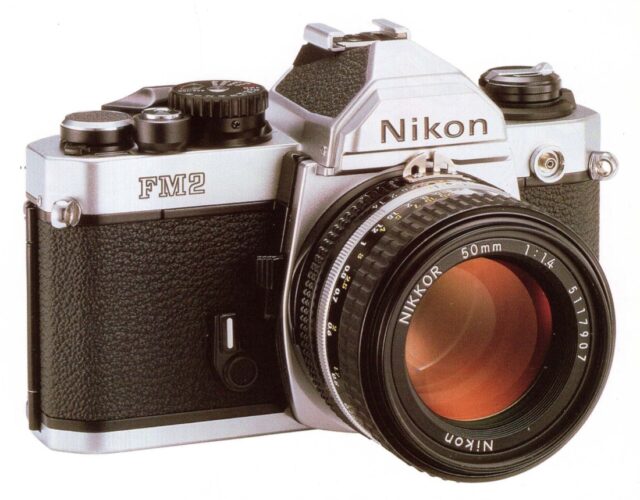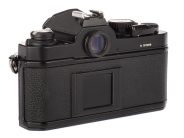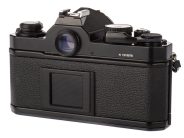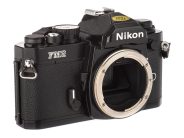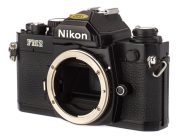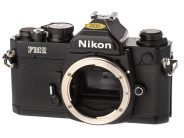Announced
Production status
System
Nikon F system cameras
- Nikkorex F
- Nikkormat EL
- Nikkormat ELW
- Nikkormat FS
- Nikkormat FT
- Nikkormat FT2
- Nikkormat FT3
- Nikkormat FTN
- Nikon D3
- Nikon D3s
- Nikon D3X
- Nikon D4
- Nikon D4s
- Nikon D5
- Nikon D6
- Nikon D600
- Nikon D610
- Nikon D700
- Nikon D750
- Nikon D780
- Nikon D800
- Nikon D800E
- Nikon D810
- Nikon D850
- Nikon Df
- Nikon EL2
- Nikon EM
- Nikon F
- Nikon F100
- Nikon F2
- Nikon F3
- Nikon F4
- Nikon F5
- Nikon F6
- Nikon FA
- Nikon FE
- Nikon FE10
- Nikon FE2
- Nikon FG
- Nikon FG-20
- Nikon FM
- Nikon FM10
- Nikon FM2
- Nikon FM2/T
- Nikon FM3A
- Nikon N2000
- Nikon N2020
- Nikon N4004
- Nikon N4004S
- Nikon N50
- Nikon N5005
- Nikon N55
- Nikon N60
- Nikon N6000
- Nikon N6006
- Nikon N65
- Nikon N70
- Nikon N75
- Nikon N80
- Nikon N8008
- Nikon N8008S
- Nikon N90
- Nikon N90S
Nikon FM2
35mm MF film SLR camera • Discontinued
Specification
| Format: | |
| 35mm full frame | |
Film type: | 135 cartridge-loaded film |
| Nikon F [46.5mm] | |
| Shutter: | |
Type: | Focal-plane |
Model: | Mechanical |
Speeds: | 1 - 1/4000 + B |
| Exposure: | |
Exposure metering: | Through-the-lens (TTL), open-aperture |
Exposure modes: | Manual |
| Physical characteristics: | |
Weight: | 540g |
Dimensions: | 142.5x90x60mm |
Manufacturer description #1
Proprietary technology in the development of shutter assemblies enabled Nikon to produce a world's first - vertical-traverse titanium shutter curtains with a slit travel time that is twice as fast as the shutter in any other 35mm SLR camera. It permits a top shutter speed of 1/4000 sec. with the FM2, as well as the fastest X-sync speed available for a camera of this type, 1/200 sec. The Nikon FM2 can stop action where a flash was once necessary. And the fast flash sync speed virtually eliminates ghost images caused at slower sync speeds, making synchro/sunlight photography easier than ever. Increasing the travel velocity of the FM2's shutter has one additional effect on camera performance. Closer tolerances on shutter timing at all high speeds.
The Nikon FM2 is a mechanical camera, requiring battery power only for the light meter and LED flash ready-light. It allows full manual control over shutter speed and aperture setting with quick and easy match-diode metering. Other features include interchangeable focusing screens, energy-saving meter switch, depth-of-field preview, self-timer, and Nikon's performance proven center-weighted metering. Like all Nikon cameras, the FM2 is constructed of the finest materials including an aluminum alloy body and back with brass top and bottom covers. Designed to stand up to professional use, the Nikon FM2 accepts the Motor Drive MD-12, Data Back MF-12 and all AI-Nikkor and Nikon Series E lenses.
Exclusive Shutter Design Provides 1/4000 sec.
In the Nikon FM2, a top shutter speed of 1/4000 sec. was achieved by reducing the weight and mass of the titanium shutter curtains. This permitted their travel velocity to be increased, a much more accurate way to achieve high speed than just using a narrower slit width. The specially treated titanium curtains are 58% lighter than conventional ones and utilize an etched honeycomb pattern to maintain strength and rigidity.
Interchangeable Focusing Screen
The standard Nikon K screen comprised of central split-image rangefinder spot, microprism collar, and matte/Fresnel outer field (12mm diameter reference circle denotes center-weighted metering area) can be removed by pressing the small latch at the top of the mirror box. The optional Type B screen has a 12mm fine ground matte focusing spot for close-up or telephoto work and the E screen shows a grid of vertical and horizontal lines which is well suited for copy work and architectural photography. (The same screens may be used in the Nikon FE.)
Full Information Viewfinder
Viewfinder shows 93% of the actual scene with excellent centering, an important asset for good composition. The selected shutter speed and aperture are shown with accurate LED match-diode metering. The LED exposure display lights in five different combinations for precise manual metering.
Depth-of-Field Preview
Conveniently located lever may be pushed to stop down lens for previewing actual depth-of-field dunng full aperture metering. Also used for stop down metering for non-meter coupled lenses.
Hot Shoe / Flash Ready LED
The hot shoe on the Nikon FM2 has an extra electrical contact which transmits a signal between camera and flash. When used with the Nikon Speedlight SB-E, SB-10 or SB-15, the LED lights to mdlcate the flash is recycled and ready to fire. If the FM2 is inadvertently set at a shutter speed faster than the top X-sync of 1/200 sec., the LED blinks to warn the user when the SB-15 or other dedicated Nikon Speedlights are used.
Shutter Speed / ASA-ISO Dial
FM2 provides mechanically-timed shutter speeds from 1-1/4000 sec., plus "B" for time exposures. Knurled shutter speed dial can be lifted to set film speed from ASA/ISO 12-6400 the widest range in its class to accommodate special emulsions and push-processing film for higher light sensitivity.
Energy-Saving Meter Switch
The FM2's shutter release button is threaded to accept a standard cable release; also functions as a meter-on switch. Depressed halfway, it turns on the viewfinder LED display. The meter shuts off automatically approximately 30 sec. after pressure is removed from the shutter release button.
Self-Timer
Mechanical self-timer provides 10 sec. firing delay, and may be cancelled. In addition, when the self-timer is activated, the mirror immediately goes up, eliminating any chance of camera shake during critical close-up or long telephoto shooting.
Multiple Exposure Lever
Lever adjacent to film advance disengages transport mechanism for intentional multiple exposures. Excellent position allows for convenient motor-driven multiple exposures as well with precise frame registration. Frame counter doesn't advance.
Manufacturer description #2
If you want manual focus and manual exposure control, here's the way to get it - with proven Nikon performance and durability. The FM2N is the choice of traditionalists everywhere.
YOU'RE IN COMMAND
The FM2N is a camera that puts you in charge. Using 60/40 center-weighted metering, you select the aperture, you select the shutter speed, to create the type of photographs you're looking for.
LEGENDARY NIKON PERFORMANCE AND DURABILITY
Like all Nikon F cameras, the FM2N is made to exacting standards with durable die-cast metal body construction and precision operating features. Vertical-travel aluminum alloy shutter curtains offer reliable, consistent performance. A mirror shock absorber virtually eliminates mirror bounce or shake that might blur some exposures. Four ball-bearing clusters and reduced film winding torque assure silky-smooth film advance.
3-POINT LED EXPOSURE DISPLAY
In addition to shutter speed and aperture, a 3-point exposure display appears in the viewfinder. It instantly tells you if your exposure is over (+), under (-) or right on (0).
MOTOR DRIVE MD-12
Attach the optional Motor Drive MD-12 to the FM2N, and you're into motor drive photography. Shoot single frames or try sequential shooting at up to 3.2 frames per second.
DATA BACK MF-16
Record year/month/day or day/hour/minute or any 2-digit number on your photographs. Perfect for scientific or research photography. LCD quartz clock ensures precision information.
F LENS MOUNT
Because the FM2N incorporates Nikon's F lens mount, it uses all of Nikon's current lenses, and hundreds of previous lenses.
OTHER NIKON ACCESSORIES
The FM2N also accepts a wide range of other Nikon accessories, including the Modulite Remote Control Set ML-2, Intervalometer MT-2, Wireless Remote Control Set MW-3, Battery Pack DB-2, Nikon Speedlights and close-up accessories.
NEW TITANIUM BODY FM2T
If you're going to extremes to get a great photograph, consider the new FM2T version of the FM2N. Made with an incredibly strong titanium outer shell, this camera is highly shock and corrosion resistant. All other specifications and features are the same as the FM2N.
Manufacturer description #3
TYPE OF CAMERA: 35mm single-lens-reflex (SLR)
PICTURE FORMAT: 24mm x 36mm (standard 35mm size)
LENS MOUNT: Nikon bayonet mount
LENSES: Nikon/Nikkor AI lenses; Non-AI lenses cannot be mounted
SHUTTER: Vertical-travel, metal, focal plane, mechanical shutter with titanium curtains
SHUTTER RELEASE: Mechanical; center-threaded shutter release button accepts AR-3 Cable Release; button locked when film advance lever is flush with camera body
SHUTTER SPEED SETTINGS: 1/4000 sec. - 1 sec. X200 (1/200 sec.), B (Bulb)
FILM ADVANCE LEVER: Single-stroke type; 30° stand-off angle and 135° winding angle
SELF-TIMER: Set/cancel mechanical type provided; approx. 10-sec. shutter release delay
VIEWFINDER: Eye-level pentaprism type; 0.86X magnification with 50mm lens set at infinity; finder coverage approx. 93% of picture field
VIEWFINDER DISPLAY: Shutter speed, ADR (aperture-direct-readout) f/stop in use, and five different LED exposure displays using "+", "o" and "-" signs
FOCUSING SCREEN: Split-image microprism type (Type K) provided as standard; matte type (B) and matte with horizontal and vertical line etchings (E) also available; screens usable with Nikon FE
REFLEX MIRROR: Automatic quick-return type incorporating special control gear and wheel-and-brake mechanism for reduced vibration and noise; non-lockable type
DEPTH-OF-FIELD PREVIEW: Provided
MULTIPLE EXPOSURE LEVER: Provided; disengages frame counter for correct count
FRAME COUNTER: Additive type (S.O.-36); automatically resets to "S" when camera back is opened
FILM REWIND: By crank provided after film rewind button is pressed
FLASH SYNCHRONIZATION: Built-in ISO-type hot-shoe; threaded sync cord terminal provided for off-camera or multi-flash photography; synchronization with electronic flash units at speeds up to 1/200 sec.
FLASH READY-LIGHT: LED provided; visible inside viewfinder; lights up when SB-15, SB-10 or SB-E Speediight unit used is fully charged; blinks to warn that the shutter speed set is beyond the electronic flash's sync range when the SB-15 or other dedicated Nikon Speediights are used
EXPOSURE METERING: Through-the-Iens center-weighted full aperture exposure measuring system using a pair of SPDs (silicon photo diodes) and metering monolithic IC circuit
METERING RANGE: EV 1 to EV 18 at ASA/ISO 100 and with f1.4 lens (i.e., from 1 sec. at f1.4 to 1/1000 sec. at f16)
FILM SPEED SETTINGS: ASA/ISO 12 - ASA/ISO 6400
POWER SOURCE: Choice of one 3V lithium battery, two 1.55V silver-oxide batteries, or two 1.5V alkaline-manganese batteries; optional Anti-Cold Battery Holder DB-2 accepting two AA-type penlight batteries available
EXPOSURE METER SWITCH: Light pressure on shutter release button switches meter on; meter stays on for approx. 30 sec. after finger leaves button, then automatically switches off; meter automatically turned off when shutter speed dial is set at X200 or B
BATTERY CHECK: LED exposure display inside viewfinder lights up when exposure meter is switched on if there is sufficient power (i.e., shutter speed dial is set anywhere except "X200" and "B")
CAMERA BACK: Opens by lifting the film rewind knob as the camera back lock is pushed counterclockwise; detachable and interchangeable with Data Back MF-12; memo holder provided
Special editions (1)
- Nikon FM2 Millennium Limited Edition (2000 units) - 2000
Similar cameras (4)
35mm full frame • Manual focus • Film • Singe-lens reflex • Nikon F mount
| Model | Shutter | Metering | Modes | Year |
|---|---|---|---|---|
| Kiev-17 aka Киев-17 |
M, 1/1000 | -- | M | 1978 ● |
| Kiev-19 aka Киев-19 |
M, 1/500 | TTL • WA | M | 1985 ● |
| Kiev-19M aka Киев-19М |
M, 1/500 | TTL • OA | M | 1988 ● |
| Kiev-20 aka Киев-20 |
M, 1/1000 | TTL • OA | M | 1983 ● |
